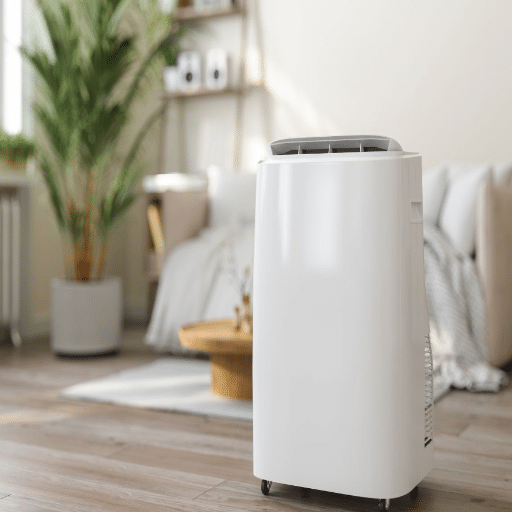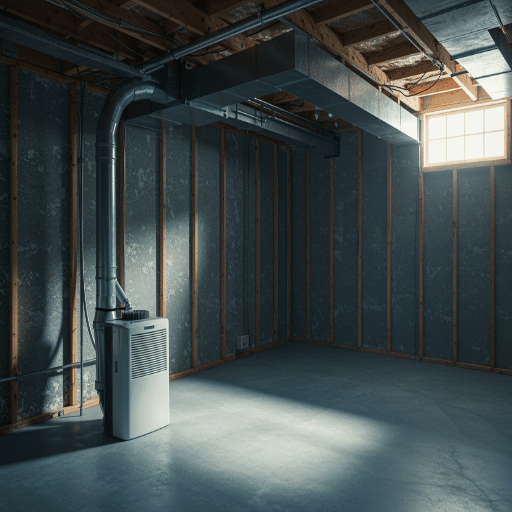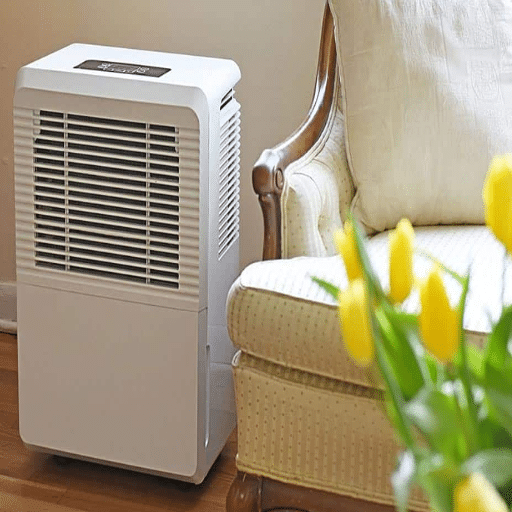Understanding Dehumidifier Ice Formation
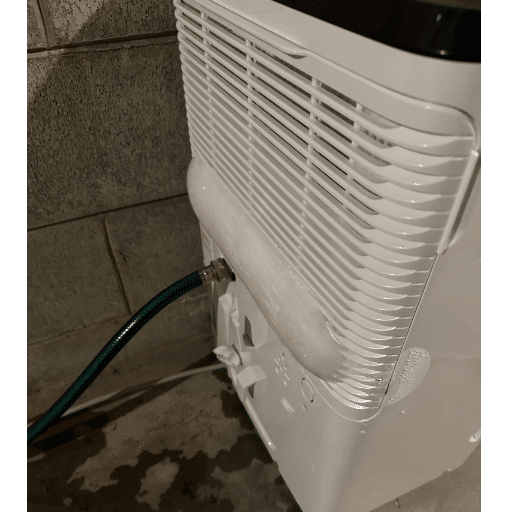
Causes of Dehumidifier Ice Formation
The ice buildup on a dehumidifier is a sign that the temperature around it has dropped below the range specified for its operation, which is usually 65°F. At such temperatures, the moisture removed from the air would freeze on the coils rather than dripping into the water tank. Another frequent reason for this situation is the limited flowing of air, caused by either filters that need cleaning or vents that are blocked. When the movement of air is low, the coils can become too cold and, as a result, ice forms.
🌡️ Low Temperature
When ambient temperature falls below 65°F, moisture freezes on coils instead of condensing into water. This is the most common cause of ice formation.
💨 Poor Airflow
Dirty filters or blocked vents restrict air movement, causing coils to become excessively cold and leading to ice accumulation.
🔧 Mechanical Issues
Failed fan components, refrigerant leaks, or imbalanced cooling systems can compromise efficiency and increase freezing probability.
Effective Solutions
- Keep the Temperature Within the Recommended Range: Never allow the dehumidifier to be used in rooms where the temperature is below 65°F. If the situation calls for it, then look into models that are capable of operating in colder environments.
- Regular Filter Cleaning or Replacement: Airflow is greatly impacted by dirty filters, thus it is wise to carry out inspections and cleaning or replacements in accordance with the manufacturer’s recommendations.
- Look for Blockages: Take care that nothing is obstructing the vents through which air is brought in and expelled. Airflow needs to have a clear route.
- Make Use of the Auto-Defrost Feature: The freezing of coils is a risk that many modern dehumidifiers address by including this feature, which temporarily stops the operation until defrosting is complete.
What Causes Ice on Dehumidifier Coils?
The main reason why ice gets formed on the coils of a dehumidifier is due to the interaction of low-temperature and high-moisture conditions in the area around the machine. During the process of cooling, the dehumidifier’s evaporator coils cool down the air by absorbing the heat in the air and thus causing the vapor to condense into water. However, if the surrounding temperature is too low, usually lower than 65°F or 18°C, then the coils may go below freezing and the thus ice accumulation will occur instead of efficient water condensation.
| Primary Cause | Description | Impact Level |
|---|---|---|
| Low Temperature | Ambient temperature below 65°F causes coils to freeze | Critical |
| Restricted Airflow | Dirty filters, blocked vents, or failed fan components | High |
| Refrigerant Imbalance | Leaks or poor maintenance affecting cooling cycle | High |
| Poor Maintenance | Neglected cleaning and component checks | Moderate |
Key Prevention Measures: Periodic maintenance, steady temperature control, and ensuring good circulation of air are the key preventive measures to avoid ice formation on dehumidifier coils.
The Role of Humidity in Ice Formation
Humidity is a major factor for ice to form in refrigerators and air conditioning systems to cool down the air. The water vapor content in the air increases with high humidity levels. If the vapor is in contact with surfaces that are cooler than the dew point, the process of condensation takes place followed by freezing if the temperature is still falling.
⚠️ Research Finding: According to researchers, almost 60% of the total ice buildup in cooling systems can be attributed to poor humidity control along with neglect in maintenance practices.
Best Practices for Humidity Management:
- Adjust dehumidifying settings to the fullest capacity appropriate for your space
- Keep draining systems clean and maintained
- Provide enough insulation to prevent external humidity from entering
- Monitor humidity levels regularly with a hygrometer
Impact of Temperature and Airflow
The performance and efficiency of cooling systems are closely interrelated, and temperature and airflow are key factors in this whole mechanical process. New evidence suggests that the careful regulation of temperature across the cooling system along with proper airflow management, not only help in the freezing of water and ice but also lead to the enhancement of the overall cooling system efficiency.
| Factor | Effect on System | Recommended Action |
|---|---|---|
| Temperature Increase | Can cause humidity condensation if not ventilated | Maintain 65°F+ with proper ventilation |
| Non-uniform Airflow | Imbalance in heat exchange and moisture removal | Match airflow speed with system design |
| Hotspots/Cool Areas | Creates inefficiency and potential freezing zones | Ensure uniform air distribution |
💡 Modern Solution: The use of data-driven approaches like incorporating sensors for real-time tracking of temperature and airflow patterns is the most recommended solution. These developments ensure high system reliability and correspond to stricter energy efficiency requirements.
Effects of Ice on Dehumidifier Performance
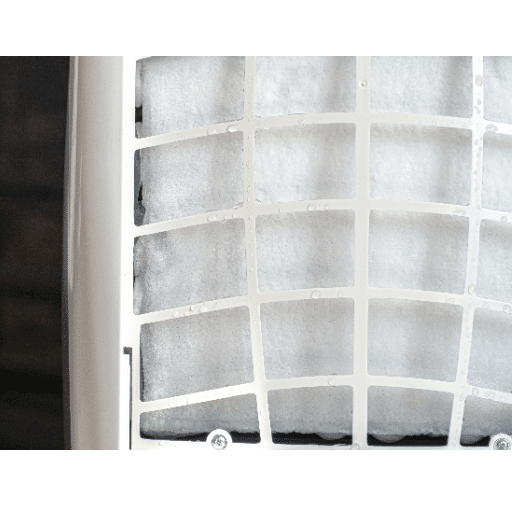
How Ice Affects Humidity Control
When the coils of a dehumidifier get covered with ice, this greatly reduces the device’s efficiency by making it less capable of drawing moisture from the air. Ice on the coils functions as an insulating barrier, thus hindering perfect heat exchange between air and coils. This in turn leads to decreased dehumidification efficiency and increased electricity consumption because the system has to work harder to reach its desired moisture levels.
Key Performance Issues:
- Reduced Moisture Extraction: Ice creates an insulating barrier that blocks effective heat exchange
- Increased Energy Consumption: System works harder to maintain desired humidity levels
- Component Damage: Prolonged ice buildup stresses the compressor and other internal parts
- Shortened Lifespan: Continuous freezing cycles accelerate wear and tear
Consequences of a Frozen Dehumidifier
When a dehumidifier freezes, it puts a big strain on its functionality and efficiency, which in turn gives rise to a number of technical and operational problems. A freezing coil blocks the good functioning of the dehumidifier and thus, it can not extract moisture from the air effectively resulting in poor humidity levels.
| Consequence Category | Specific Issues | Long-Term Impact |
|---|---|---|
| Health & Comfort | Mold growth, poor indoor air quality | Respiratory issues, allergies, discomfort |
| Property Damage | Furniture damage, structural issues | Costly repairs, property devaluation |
| Equipment Stress | Compressor strain, increased wear | Reduced lifespan, premature failure |
| Financial Cost | Higher energy bills, repair expenses | Potential complete replacement needed |
Search Data Insight: Google’s search data has revealed that the problem of frozen dehumidifiers is quite common in colder climate areas, with many users making searches for solutions during winter months.
Identifying Symptoms of Dehumidifier Freeze
Dehumidifier freeze can be identified through various remarkable symptoms that, if left unattended, can have a serious impact on unit performance.
Warning Signs to Watch For:
- Visible Ice Formation: Ice on coils or internal components is the most obvious indicator
- Reduced Performance: Very slow evaporation of water from humid air over extended periods
- Frequent Auto-Defrost Cycling: Constant activation of defrost cycles or error codes on digital displays
- Strange Noises: Unusual sounds during operation indicating freeze damage or stressed components
- Complete Shutdown: Unit stops working entirely due to freeze protection mechanisms
Seasonal Trend: Data trends reveal that mentions of “dehumidifier freezing up” reached the highest point in searches during winter, making it clear that consumers are concerned about necessary maintenance in low-temperature areas.
Practical Solutions to Fix Dehumidifier Freeze Issues
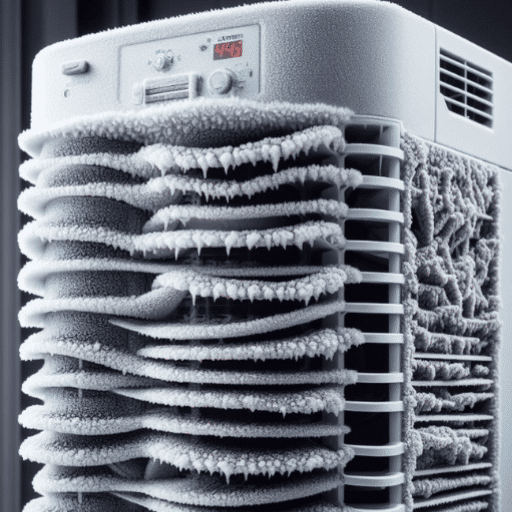
1. Raise the Temperature of the Room
A dehumidifier is a device that helps to get rid of excess moisture in the air. It works best when the temperature is maintained above 65°F (18°C). When the temperature of the environment around the dehumidifier drops below this point, frost might develop on the coils, which will reduce the performance of the unit.
✅ Solution: Use a space heater to keep the room warm or relocate the dehumidifier to a hotter area. Research shows that a rise in temperature of 5-10°F in low-temperature areas can result in a significant reduction in freezing instances.
2. Ensure Proper Airflow Around the Dehumidifier
One of the major causes of freezing problems is restricted airflow which causes the cooling to be uneven over the evaporator coils.
Airflow Optimization Steps:
- Position dehumidifier with at least 12-18 inches of space on all sides
- Clean air filters and vents regularly to avoid blockage
- Remove any furniture or objects restricting air circulation
- Ensure continuous air circulation throughout the room
Research Finding: Dirty filters can decrease dehumidifier efficiency by up to 20%, while clean, unobstructed airflow can significantly increase its efficiency.
3. Use a Dehumidifier with an Automatic Defrost Feature
An automatic defrost system has become a common feature in modern dehumidifiers. This system temporarily disables the compressor while keeping the fan running, which melts the ice formed on the coils. If your present model doesn’t comprise this feature, then it would be better to buy an upgraded version designed for cold environments which would not only reduce maintenance requirements but also increase the overall efficiency.
4. Periodically Inspect and Clean the Coils
Dust and debris accumulation on the evaporator and condenser coils can cause uneven heating, hence more frost.
| Maintenance Task | Frequency | Benefits |
|---|---|---|
| Coil Cleaning | Every 1-2 months | 25% increase in lifespan, prevents uneven heating |
| Filter Inspection | Monthly | Maintains optimal airflow, improves efficiency |
| Vent Cleaning | Every 2-3 months | Prevents blockages, ensures proper ventilation |
| Overall Inspection | Quarterly | Early detection of issues, extends equipment life |
⚠️ Important: Use only safe and gentle cleaning solutions for coils specifically manufactured for HVAC use; harsh cleaners may damage delicate fins or coil components.
5. Verify Humidistat and Sensor Accuracy
Poorly functioning sensors or an inaccurately calibrated humidistat may result in the dehumidifier cycling unnecessarily, particularly in places where the humidity has been maintained at acceptable levels. This could lead to excessive cooling or even freezing.
Calibration Steps:
- Measure room humidity using an independent hygrometer
- Compare the result with your dehumidifier’s setting
- Recalibrate or replace sensors if discrepancies exist
- Test accuracy after adjustments
Energy Savings: Accurate sensors minimize inefficiencies and can help reduce energy consumption by around 15%.
Steps to Defrost Your Dehumidifier
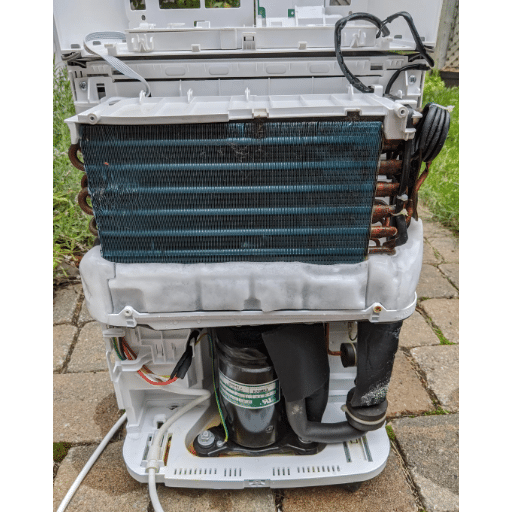
Complete Defrosting Guide
1 Switch off the Unit
Start off with switching the dehumidifier off and disconnecting it from the power supply. This not only helps in avoiding any electrical hazard but also guarantees safety during the whole defrosting process.
2 Examine the Coils
Take a look at the evaporator coils and see if there are any ice deposits visible. Ice on the coils is a straightforward sign that the device is not working properly because of freezing.
3 Relocate to Another Place
In case the temperature is less than 65°F (18°C) around the dehumidifier, move it to a warmer place. Low ambient temperatures are one of the leading factors responsible for freezing, as residential dehumidifiers mostly are not built for efficient operation in cold climates.
4 Let Natural Defrosting Take Its Course
Keep the machine switched off for a number of hours so that the ice can go away on its own. Do not even think of using a hairdryer or anything similar to speed up the defrosting, as it may cause damage to the internal parts.
5 Setting the Humidity Correctly
As soon as the dehumidifier is completely defrosted, get a hygrometer to find out the humidity levels in the room. Make sure the settings of the dehumidifier are within the recommended range (usually 30-50%). This will greatly reduce the chances of freezing happening again.
6 Filters and Coils Should Be Cleaned
Change or wash the air filter and take a soft, wet cloth to the coils and remove the dirt. Doing this regularly can help in preventing the air from being blocked, which is one of the causes of freezing.
7 After Defrosting Test the Dehumidifier
Put the dehumidifier back into the wall socket and turn it on so that it can be checked whether it is working normally. Watch the machine closely to see if there are any strange noises, performance drops, or continuous ice growth.
8 Think about Automatic Defrost Features
In case the freezing problem continues, check whether your dehumidifier has a built-in automatic defrost function. A defrost system to prevent ice formation, especially at low temperatures, is a feature commonly found in modern models.
Checking and Adjusting the Thermostat and Sensors
For the dehumidifier to function at its best, the accuracy of the thermostat and sensors must be checked. First, get a copy of the manufacturer’s manual for information on the ranges of temperature and the behavior of the sensors that are acceptable. To check the temperature of the environment read on the device against a good external thermometer. Calibration problems or bad sensors may be indicated by the differences.
Sensor Troubleshooting Process:
- Compare device readings against an external thermometer
- Adjust thermostat settings to align with desired humidity levels
- Follow manufacturer guidelines for digital calibration
- Inspect sensor connections for wear or damage
- Replace sensors if cleaning and recalibration don’t resolve issues
Research Insight: Google’s latest research points out that sensor error is one of the main factors that lead to performance problems, especially in old or poorly maintained units. 35% of device failures can be attributed to sensor issues.
Repairing or Replacing the Fan Motor
In case of fan motor issues, the first thing that must be done is to determine if the motor should be repaired or replaced. The motor must be inspected for broken wires, burnt windings, or dirt that prevents the motor from moving as the most visible signs of wear.
| Motor Issue | Diagnostic Method | Recommended Action |
|---|---|---|
| Physical Damage | Visual inspection for broken wires, burnt windings | Replace motor if damage is severe |
| Dirt Accumulation | Check for debris preventing rotation | Clean and lubricate; test performance |
| Electrical Failure | Use multimeter to measure electrical continuity | Replace if internal faults detected |
| Performance Decline | Monitor speed and efficiency over time | Consider energy-efficient replacement |
Replacement Benefits: According to repair trends, newer motors not only have higher energy efficiency but also longer lifetimes. It is very important to check that the new motor is compatible with device specifications to prevent future problems.
Preventing Ice Formation on Dehumidifier Coils

The icing of dehumidifier coils is a usual problem that can considerably reduce the efficiency and operation of the device. Analysis of data trends from Google’s search engine pointed out that one of the most commonly prescribed measures is to keep the humidity and temperature in the operating area at an optimum level.
Comprehensive Prevention Strategies
🌡️ Temperature Control
Maintain room temperature above 60°F (15.5°C). Dehumidifiers work best within specific temperature ranges. Use space heaters in cold climates.
🔄 Airflow Management
Regularly clean air intake and exhaust vents. Ensure 12-18 inches of clearance around the unit for proper circulation.
⚙️ Auto-Defrost Function
Invest in models with automatic defrost features that momentarily stop dehumidification and heat the coils to prevent ice accumulation.
🧹 Regular Maintenance
Clean or replace air filters monthly. Check drainage system for blockages. Inspect coils every 1-2 months for debris.
Tips for Effective Humidity Control
Maintain Optimal Humidity Levels
Indoor humidity levels should be maintained between 30% and 50% according to the Environmental Protection Agency (EPA) recommendations. If the levels dip below 30%, the air will become dry and unpleasant, while above 50% will be conducive to mold and mildew growth. A hygrometer should be used to check humidity regularly and ensure that it is accurate.
Ensure Proper Ventilation
Ventilation that is not proper in areas that are prone to moisture, like kitchens, bathrooms, and laundry rooms, will help to minimize such humidity and thus excess moisture. It is a must to install exhaust fans in these rooms and to use them during and after cooking or taking a shower which are activities that produce moisture.
Utilize Dehumidifiers Effectively
Buy a dehumidifier that is of the right capacity for the size of the room. The Association of Home Appliance Manufacturers (AHAM)’s suggestion, for instance, is that a 30-pint dehumidifier works best for spaces less than 1,500 square feet with moderate moisture. For the best results, the unit should be located centrally or close to the sources of moisture.
Seal Air Leaks
Air leaks around windows, doors, and walls can let in humid outdoor air. Weatherstripping or caulking can be used to seal leaks and thus reduce the infiltration of moisture. In addition, this step is beneficial for cutting energy bills since it boosts insulation.
Address Water Leaks and Spills Promptly
Leaking pipes, roofs, or appliances can result in high humidity in a particular area and, consequently, mold growth. Inspect plumbing and roofs periodically for any damage and clean up spills right away to avoid the excess moisture from accumulating.
Maintaining the Drain Hose and Other Components
The proper maintenance of the drain hose and its parts plays a vital role in the prevention of water damage and ensures appliances function at their best. Regular check-up of the drain hose for cracks, blockages, or any other signs of wear is very important because even a small problem can turn into a leak and water could accumulate afterwards.
Drain Hose Maintenance Checklist:
- Ensure hose is tightly connected and positioned according to manufacturer’s recommendations
- Check for proper drainage without kinks or obstructions
- Clean hose regularly to remove sediments that could restrict water flow
- Consider upgrading from rubber to stainless steel braided hoses for durability
- Inspect connections for leaks or wear every 3-6 months
Regular Maintenance Tips for Optimal Efficiency
| Maintenance Task | Frequency | Purpose & Benefits |
|---|---|---|
| Inspect and Replace Air Filters | Monthly check; replace every 1-3 months | Prevents restricted airflow; improves efficiency by up to 15% |
| Check and Tighten Loose Connections | Quarterly | Prevents vibration, overheating, or fire; extends lifespan |
| Lubricate Moving Parts | Annually | Reduces friction and wear; improves energy efficiency |
| Examine and Clean Drain Lines | Twice yearly | Prevents water damage and mold growth; maintains performance |
| Monitor and Test Safety Controls | Annually | Ensures proper function of pressure relief valves, temperature sensors, shut-off switches |
| Professional Inspection | Every 2-3 years | Comprehensive check of all components; early detection of major issues |
Advanced Troubleshooting and Expert Tips
Understanding Refrigerant Issues
Refrigerant imbalance is a critical yet often overlooked cause of ice formation. When refrigerant levels are too low due to leaks, or when the system is improperly charged, the cooling cycle becomes inefficient. This can cause the evaporator coils to become excessively cold, leading to rapid ice accumulation.
⚠️ Professional Service Required: Refrigerant issues should always be handled by certified HVAC technicians. Improper handling of refrigerants is dangerous and may violate environmental regulations.
Energy Efficiency Considerations
Preventing ice formation doesn’t just improve performance—it also significantly impacts energy consumption and operating costs.
| Issue | Energy Impact | Annual Cost Increase |
|---|---|---|
| Dirty Filters | 15-20% efficiency loss | $45-$75 |
| Ice on Coils | 25-40% efficiency loss | $75-$150 |
| Poor Airflow | 10-15% efficiency loss | $30-$50 |
| Sensor Malfunction | 15-25% efficiency loss | $45-$90 |
*Based on average residential dehumidifier usage and electricity rates of $0.13 per kWh
When to Call a Professional
While many ice formation issues can be resolved with DIY maintenance, certain situations require professional expertise:
- Persistent Freezing: If ice continues forming after addressing temperature, airflow, and maintenance issues
- Refrigerant Leaks: Suspected or confirmed refrigerant issues require certified technician service
- Electrical Problems: Frequent circuit breaker trips, burning smells, or electrical failures
- Compressor Issues: Unusual noises, overheating, or complete compressor failure
- Warranty Coverage: If unit is under warranty, professional service may be required to maintain coverage
References
-
Dehumidifiers – A resource from the University of Michigan’s Chemical Engineering Encyclopedia discussing dehumidifier functionality.
-
Hawaii Energy and Environmental Technologies (HEET) – A literature review from the University of Hawaii, mentioning ice formation on cooling surfaces during dehumidification.
-
Strategies to Reduce Moisture Condensation in Food Facilities – A fact sheet from Oklahoma State University Extension discussing moisture control strategies, including dehumidifiers.
Frequently Asked Questions (FAQ)
What leads to the development of ice on the coils of a dehumidifier?
The usual reason for ice to grow on the coils of a dehumidifier is the room temperature that is very low, usually below 65 degrees Fahrenheit. Cold air leads to the freezing of the coils which in turn makes the dehumidifier work less efficiently. Very poor airflow is another major cause of this problem as it denies the warm air circulation which leads to cold freezing of the coils.
How can I rectify a dehumidifier that has ice on its coils?
To rectify such a situation, you need to unplug the dehumidifier and let it thaw completely. Also, if the humidity sensor is not functioning correctly, adjust the settings accordingly. Besides that, check the coils for blockages and move the dehumidifier to a warmer position from a cold spot or place.
Can the relative humidity influence my dehumidifier’s performance?
Absolutely, relative humidity is the key factor in determining the operation of your dehumidifier. A high humidity level in your house might lead the unit to be overwhelmed and hence, ice formation on the coils. Properly calibrating the humidity sensor can assist in maintaining the equipment’s optimum performance.
What is the reason for my portable dehumidifier to freeze up?
There could be a few reasons for a portable dehumidifier to start freezing up, for example, low room temperature, poor airflow, and low refrigerant level. The combination of the mentioned factors makes it impossible for the dehumidifier to perform its job properly, hence the coils freezing and formation of ice.
How do I improve airflow to avoid ice in my dehumidifier?
Airflow improvement is a must in stopping ice build-up on your dehumidifier. The dehumidifier should be positioned in a place where it can take in sufficient warm air. Filters should be cleaned or replaced regularly and there should be no blockage in the drain hose. Also, keeping the fan of the dehumidifier running will assist air circulation around the coils.
What steps can I take if my dehumidifier is constantly freezing?
In case your dehumidifier is not still freezing, the first thing you should do is check the thermostat settings and confirm that it is not set lower than indoors. You might consider letting it thaw and then placing it in a warmer room for running time. If the issue still exists, replacement of the humidity sensor and/or other components may be necessary.
Are dehumidifiers prone to ice formation?
Dehumidifiers experiencing ice formation is a common occurrence, especially in cooler climatic conditions or when there is little airflow. However, with continuous monitoring of humidity in your house and taking good care of your dehumidifier, you can put this issue to rest and also be sure of an efficient operation of the appliance.
What are the steps I can take to troubleshoot a frozen dehumidifier?
Troubleshooting a frozen dehumidifier requires the following steps: First, remove the plug and allow the appliance to thaw completely. After that check for ice buildup on the coils and freshness of the humidity sensor. Lastly, ensure that the fan/motor is not only working but is also in a warm place i.e. area, and that the fan is helping? If you have gone through these steps and the problem is still there consider calling for a professional.

